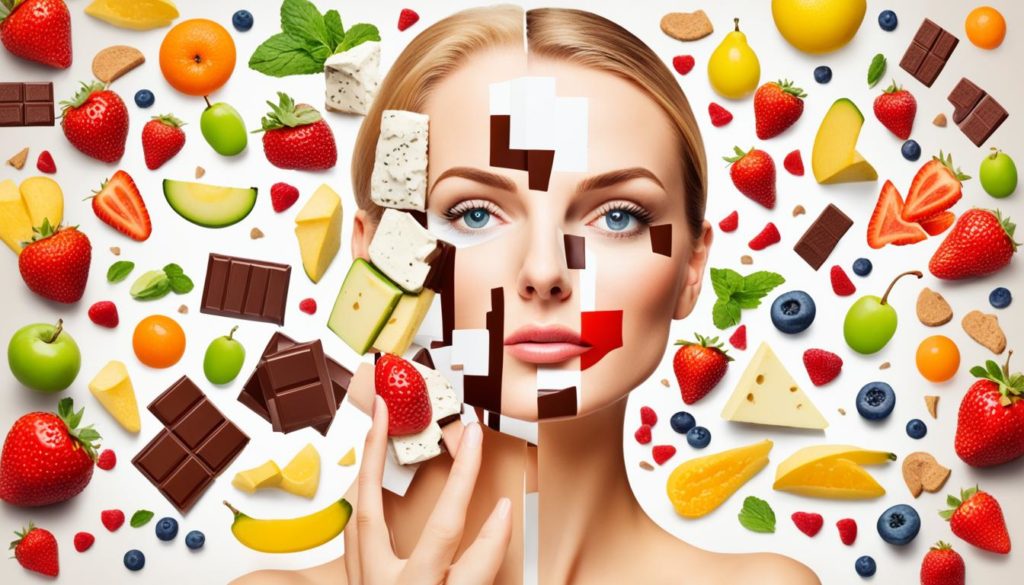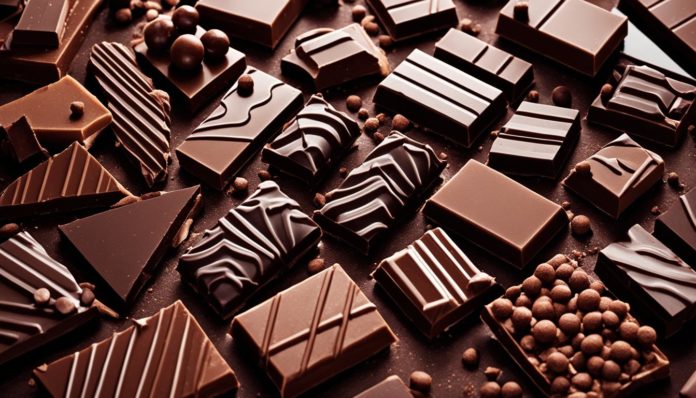About 50 million Americans battle with acne annually, making it the most common skin issue in the U.S. People often wonder if what they enjoy, like chocolate, could trigger acne. The debate on whether chocolate causes acne has gone on for years. This article explores the link between chocolate and acne, looking at historical views and what science says now. It also considers how diet may affect your skin.
Key Takeaways
- An estimated 50 million Americans suffer from acne each year.
- The relationship between chocolate and acne has been a subject of debate for decades.
- Understanding the connection or lack thereof between chocolate consumption and acne is crucial.
- This article will explore various perspectives and scientific views on the topic.
- Key aspects to be discussed include dietary influences, study outcomes, and chocolate varieties.
The Historical Perspective on Chocolate and Acne
The link between chocolate and acne has been debated for a long time. This section looks into the past beliefs about chocolate and skin. We will see how these ideas have changed over the years.
Early Beliefs
Long ago, people thought chocolate had health benefits. The Mayans and Aztecs used chocolate in different ways, thinking it was medicinal. Yet, they didn’t really connect it to acne until much later.

In the 19th and early 20th centuries, chocolate making grew. At that time, some skin doctors began to say that eating chocolate might cause acne. This idea stuck around until the mid-20th century. But, there wasn’t much proof to back it up.
Modern Scientific Views
Views on chocolate and acne have changed a lot recently. Now, scientists study how food affects our skin. They find that chocolate’s effect varies from person to person.
Today’s studies look into things like sugar and other ingredients in chocolate. This new research challenges old beliefs. It helps us understand skin health better.
“Historical belief about chocolate’s impact on skin health reflects broader societal attitudes towards diet and dermatology, illustrating how scientific knowledge evolves over time.” — Dr. Amy Smith, Dermatologist
How Diet Influences Acne Development
There’s a link between what we eat and acne. Foods, especially high-glycemic ones and dairy, often trigger breakouts.
The Role of High-Glycemic Foods
High-glycemic foods cause your blood sugar to spike. This can make your body produce more insulin. That leads to more sebum and inflammation, which cause acne.
We often find dietary triggers for acne in processed foods, sweet snacks, and drinks. Eating more fruits, vegetables, and whole grains can help control acne.

Dairy Products and Skin Health
Recent studies show a strong link between dairy intake and acne. Milk hormones might clog pores and worsen acne.
Some notice clearer skin by eating less dairy. It’s important to watch how much milk, cheese, and other dairy you have. This can help find what triggers your acne.
| Type of Food | Skin Impact |
|---|---|
| High-Glycemic Foods | Increased blood sugar levels, insulin spikes, sebum production |
| Dairy Products | Clogged pores, hormonal influences, acne lesions |
| Low-Glycemic Foods | Stable blood sugar levels, reduced sebum production |
The Science Behind Chocolate’s Impact on Skin
Many have debated the link between chocolate and pimples. To understand chocolate’s role in skin reactions, we must examine its scientific aspects. We’ll look into chocolate’s content and how it may affect skin health.
Cocoa Content and Skin Reactions
Cocoa is chocolate’s main ingredient and has many bioactive compounds. Some studies say high cocoa levels can irritate the skin and cause pimples. But other research finds no direct link to acne. This shows how complex chocolate’s effects on skin can be.
Other Ingredients in Chocolate Confections
Chocolate also has sugar, milk, and fats that could harm the skin. For example, sugar raises insulin, which might increase oil in skin glands, leading to pimples. Milk in chocolate can also trigger hormones that might cause acne.
| Ingredient | Possible Skin Impact |
|---|---|
| Cocoa | Bioactive compounds may cause irritations |
| Sugar | Can spike insulin levels, increase oil production |
| Milk | May stimulate hormones triggering acne |
We’ve broken down chocolate’s ingredients and their possible skin effects. While cocoa’s link to skin health gets attention, we can’t ignore the overall impact of chocolate’s ingredients. Understanding these helps explain why some might react more to chocolate than others.
Chocolate and Acne Studies: What the Research Says
Researchers have long tried to understand how chocolate affects acne. Yet, they haven’t agreed on an answer.
Conflicting Study Outcomes
Many studies have looked into chocolate’s impact on skin health. Results have been mixed. Some studies say chocolate can cause more acne. But, others don’t see a link. For example, a study in the Journal of Clinical and Aesthetic Dermatology saw more acne after eating chocolate. On the other hand, the American Journal of Clinical Nutrition found no clear effect.
Factors Influencing Study Results
Why do these studies not agree? Many reasons exist. The way studies are done, such as how many people are in them, affects the results. Bigger studies tend to be more reliable. Who participates, like their age or genes, matters too. Seeing if it’s just chocolate or what people eat with it that affects acne is hard.
Chocolate Varieties and Their Potential Effects on Skin
Different types of chocolate affect our skin in unique ways. The main difference lies in their cocoa content and ingredients. Dark chocolate and milk chocolate react differently with our skin.
Dark Chocolate vs. Milk Chocolate
Dark chocolate, with its cocoa content over 70%, brings many benefits. It is packed with antioxidants. These fight inflammation and help keep our skin healthy. On the other hand, milk chocolate has less cocoa and more sugar and milk. It might lead to milk chocolate acne problems for some people.
Other Chocolate Varieties
There’s more to chocolate than just dark and milk varieties. Take white chocolate, for example. It doesn’t have cocoa solids, just cocoa butter, sugar, and milk. So, it doesn’t offer the antioxidant benefits dark chocolate does. High sugar content can also cause skin issues. Chocolates with extras like nuts or caramel can affect your skin too, depending on those extra ingredients. Knowing how different chocolates impact skin health is key to making good choices.
Benefits of Dark Chocolate for Skin Health
Dark chocolate is loved not just for its taste, but for its skin benefits too. It’s full of compounds good for the skin.
Antioxidant Properties
Dark chocolate has lots of antioxidants. These fight oxidative stress, which ages skin and causes damage. Eating dark chocolate can make your skin stronger against environmental harm.
Anti-inflammatory Effects
It’s known for reducing inflammation, thanks to cocoa compounds. This can lessen acne and other skin issues. Dark chocolate is great for skincare.
Common Misconceptions About Chocolate and Acne
Many people think eating chocolate causes acne. This belief has been around for a long time. But research tells us a different story. It’s time to clear up some myths about chocolate and skin problems.
One myth is that all types of chocolate are equally bad for your skin. But it’s not that simple. The kind of chocolate you eat matters. For example, dark chocolate is full of antioxidants and might even be good for your skin.
Another myth is the belief that eating chocolate immediately causes breakouts. Acne is complicated and not caused by just one thing. Factors like genetics and hormones play a big role. It’s too simple to blame chocolate alone for skin issues.
| Myth | Fact |
|---|---|
| Chocolate causes acne | Acne is influenced by multiple factors; there’s no direct causal link. |
| All chocolates are harmful to skin | Dark chocolate has antioxidants that may benefit skin health. |
| Immediate breakouts are due to chocolate eating | Acne development is complex and involves various factors. |
Addressing these myths is important. Yet, understanding how diet affects skin health is key. As we sort through chocolate and acne myths, it’s vital to tell real facts from stories. This helps us make better choices about what we eat and how it affects our skin.
Personalizing Your Diet: Dealing with Acne and Chocolate Consumption
To manage acne well, create a personal diet plan. It’s important to know which foods cause your breakouts. With chocolate dietary triggers, reactions can vary. Start by logging what you eat and watching how your skin reacts. This helps figure out chocolate’s effect on your acne.
Identifying Potential Food Triggers
Finding food triggers needs patience and careful observation. Foods that spike blood sugar and dairy might make acne worse. Using a food diary is a good way to track what causes problems. For some, chocolate is an issue because of its sugar, yet dark chocolate might be less troublesome thanks to less sugar.
Balancing Enjoyment and Skin Health
To keep skin healthy while enjoying treats, balance is crucial. Choose dark chocolate for its high cocoa and low sugar. This can help avoid acne. Also, eating more low-glycemic foods like veggies and whole grains helps clear the skin.
| Chocolate Type | Potential Skin Impact |
|---|---|
| Dark Chocolate (70%+ cocoa) | Lower breakout potential due to less sugar |
| Milk Chocolate | Higher in sugar, higher breakout potential |
| White Chocolate | High in sugar and dairy, highest breakout potential |
Conclusion
Examining the link between chocolate and acne gives us a detailed look at their relationship. History shows how thoughts on chocolate and acne have changed over time. Today’s dietary science explains how some foods, including chocolate, might influence acne.
Research on how chocolate affects our skin points to key ingredients. Sugar and milk in chocolate are crucial. They contribute to the debate, showing why studies sometimes disagree. It’s crucial to consider study methods and how everyone’s skin is different.
Dark chocolate could be good for your skin, thanks to its antioxidants. Yet, many people are still unsure about chocolate’s effects. Knowing what foods might cause acne can help balance eating habits and skin care. This info helps readers make better choices about eating chocolate and taking care of their skin.
FAQ
Is Chocolate Linked to Acne Breakouts?
The link between chocolate and acne sparks much debate. Some research suggests a link, but nothing is sure. Everyone is different, and other foods matter too.
What is the Historical Perspective on Chocolate and Acne?
Early beliefs claimed chocolate caused acne, but ideas have changed. Ancient views varied on chocolate and health. Now, we use better science to check these old ideas.
How Does Diet Influence Acne Development?
What we eat affects acne a lot. Foods that spike blood sugar may cause breakouts. Also, dairy might lead to acne for some. Watching what you eat helps find triggers.
What is the Science Behind Chocolate’s Impact on Skin?
Ingredients in chocolate, especially cocoa, might affect the skin. Cocoa is being studied for its skin effects. But, sugar and milk in chocolate could worsen acne for some folks.
What Do Studies Say About Chocolate and Acne?
Studies give mixed messages about chocolate and acne. They vary in outcomes, affected by who’s being studied. We need to look closely at the research to get the full picture.
How Do Different Chocolate Varieties Affect Skin?
Dark and milk chocolates impact the skin differently. Dark chocolate, richer in cocoa and less in sugar, might affect the skin less than milk chocolate does.
Are There Benefits of Dark Chocolate for Skin Health?
Dark chocolate is full of antioxidants and can fight inflammation. This might help reduce acne and improve skin health. The benefits could help lessen acne and make skin healthier.
What Are Common Misconceptions About Chocolate and Acne?
Many myths exist about chocolate and acne. A common one is that chocolate directly causes pimples. We need real evidence to clear up these myths and focus on facts.
How Can You Personalize Your Diet to Deal with Acne and Chocolate Consumption?
Finding out what foods trigger your acne is crucial. You can still enjoy chocolate by being smart about it. Choose dark chocolate with fewer additives for a better balance.


